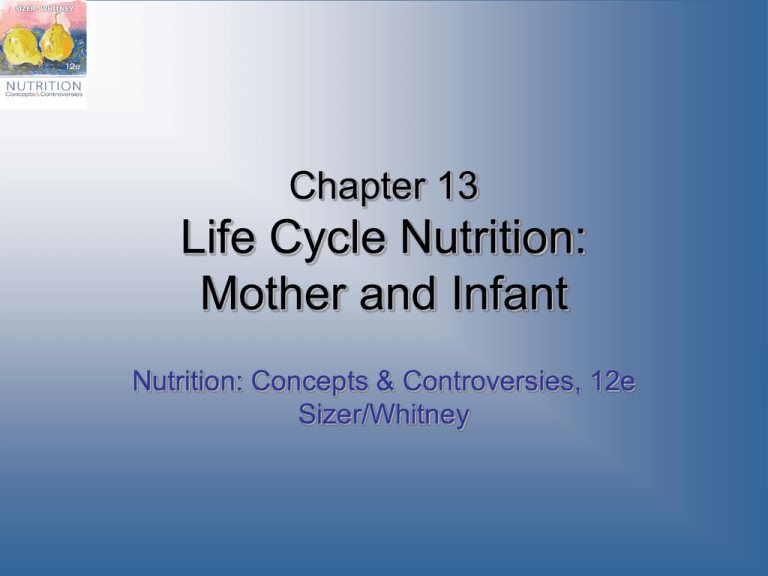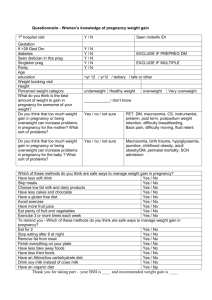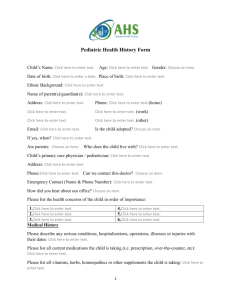Slide 1 - Cengage Learning
advertisement

Chapter 13 Life Cycle Nutrition: Mother and Infant Nutrition: Concepts & Controversies, 12e Sizer/Whitney Learning Objectives Explain why a nutritionally adequate diet is important long before a pregnancy is established. Identify the special nutritional needs of a pregnant teenager as compared to a pregnant adult. Evaluate the statement that “no level of alcoholic beverage intake is safe or advisable during pregnancy.” Learning Objectives Describe the impacts of gestational diabetes and preeclampsia on the health of a mother and her unborn child. Discuss the nutrition and health benefits of breastfeeding to both the mother and the child. Discuss some relationships between childhood obesity and chronic diseases. Learning Objectives Develop a healthy eating and activity plan to help an obese child improve his or her short-term and long-term health overall. Preparing for Pregnancy Establish eating habits before pregnancy Fathers-to-be Mothers-to-be Pregnancy weight Appropriate body weight before pregnancy Obese and underweight women Low birthweight infant Infant mortality rate Infant Mortality Decline Over Time Preparing for Pregnancy Healthy placenta and other organs Placenta Supply depot and waste-removal system Two bloods never mix Metabolically active organ Umbilical cord Amniotic sac Poor maternal nutrition prior to pregnancy could affect her grandchildren and children The Placenta The Events of Pregnancy Fertilized ovum is called a zygote Implantation Within two weeks of fertilization Fetus at eight weeks Physical changes Fetal period Gestation = 40 weeks Trimesters Critical periods Stages of Embryonic and Fetal Development Increased Need for Nutrients Energy Vary with progression of pregnancy Carbohydrate Protein DRI for pregnancy Supplements Discretionary calories Increased Need for Nutrients Folate Recommendation increases during pregnancy Neural tube defects (NTD) Anencephaly Spina bifida Enrichment of grain products Vitamin B12 Assists folate with manufacture of new cells Spina Bifida Rich Folate Sources Increased Need for Nutrients Vitamin D Rickets Calcium Absorption doubles during pregnancy Recommendations are aimed at preserving maternal bone mass DRI recommendations Increased Need for Nutrients Iron Iron needs of fetus take priority Iron supplements Enhancing absorption Zinc Supplementation during pregnancy is not advised Prenatal supplements Example of a Prenatal Supplement Label Food Assistance Programs Special Supplemental Nutrition Program for Women, Infants, and Children (WIC) Nutritious foods Nutrition education Referrals to health and social services Benefits of the program Supplemental Nutrition Assistance Program Weight and Pregnancy Weight gain Women must gain weight during pregnancy Benefits of appropriate weight gains Ideal weight-gain pattern Nearly all lean tissue Weight loss and pregnancy Typical woman does not return to prepregnancy weight Recommended Weight Gains Based on Prepregnancy Weight Components of Weight Gain During Pregnancy Pregnancy and Physical Activity Benefits of physical activity Consult physician Types of activities Recommendations Prevent dehydration Prevent high internal temp. Teen Pregnancy Special case of intense nutrient needs Frequent teen deficiencies Less likely to receive prenatal care More likely to smoke Risks associated with teen pregnancy Infant Mother Cravings and Aversions in Pregnancy Cravings and aversions are common Do not reflect physiological needs Pica Often associated with iron deficiency “Morning” sickness Hormones Some Cautions for the Pregnant Woman Smoking Damage to fetal DNA Developmental defects or diseases Complications of birth Risk of SIDS Medicinal drugs and herbal supplements No OTC drugs or herbal supplements Prescriptions only with doctor’s advice Some Cautions for the Pregnant Woman Drugs of abuse Cross the placenta Complications of use Environmental contaminants Lead Mercury Fish consumption Some Cautions for the Pregnant Woman Foodborne illness Listeriosis Foods to avoid Vitamin-mineral megadoses Vitamin A Dieting Sugar substitutes Caffeine Drinking During Pregnancy Labeling of alcoholic beverages Alcohol crosses placenta & is toxic Direct effects in fetus Fetal Alcohol Syndrome Drinking alcohol during pregnancy Fetal Alcohol Spectrum Disorders (FASD) Fetal Alcohol Syndrome (FAS) Alcohol-Related Neurodevelopmental Disorder (ARND) Alcohol-Related Birth Defects (ARBD) Expert advice Typical Facial Characteristics of FAS Troubleshooting - Diabetes Special challenges for disease management Problems with poor glycemic control Continuation of intensified management after pregnancy Gestational diabetes Diabetes risk later in life Increased odds of surgical birth and high infant birthweight Troubleshooting – Hypertension & Preeclampsia Hypertension Chronic vs. gestational hypertension Risks for mother and fetus Preeclampsia High blood pressure and protein in urine Occurrence Advancement to eclampsia Lactation Preparation before birth Read books Consult a certified lactation consultant Learn about nutritional requirements Nutrition During Lactation Energy cost 500 calories per day above a woman’s need Fluid need Prevent dehydration Variations in breast milk Quantity vs. quality of milk Food sensitivities and allergies Weight loss Gradual When Should a Woman Not Breastfeed? Alcohol and illicit drugs Alcohol concentration peak within 1 hour Illicit drug users should not breastfeed Tobacco and caffeine Medicines Danger levels vary – consult physician Oral contraceptives When Should a Woman Not Breastfeed? Environmental contaminants Maternal illness Common cold Hepatitis or tuberculosis HIV World Health Organization (WHO) Feeding the Infant Nutrient needs Growth rate Weight and length Basal metabolic rate Energy nutrients Vitamins Water Nutrient Recommendations for an Infant & an Adult Male Compared on the Basis of Body Weight Why Is Breast Milk So Good for Babies? AAP and ADA position Excels as source of nutrients Vitamin D Immune factors Easily digested Energy-nutrient balance Lipids Why Is Breast Milk So Good for Babies? Vitamins and minerals in breast milk Vitamin D supplements Supplements for infants Vitamin D, iron, fluoride, vitamin K Immune factors Colostrum Benefits of breast milk with infection Other possible benefits Formula Feeding Offers an acceptable alternative to breastfeeding Nutrient composition Special formulas Transition to cow’s milk 1 year of age Dietary indicators of readiness for cow’s milk Percentages of Energy-Yielding Nutrients in Breast Milk, Infant Formula, & Cow’s Milk Infant’s First Foods Governing considerations Nutrient needs Iron and vitamin C Physical readiness Ability to swallow Need to detect & control allergic reactions Introduce single-ingredient foods one at a time Infant’s First Foods Choices of foods Variety, balance, moderation Fat restriction Foods to omit Sweets and baby desserts Sugar alcohols Canned foods honey Looking Ahead First year of life lays the foundation for future health Encourage healthy eating habits Avoid concentrated sweets Encourage physical activity Nursing bottle syndrome Childhood Obesity and Early Chronic Diseases Controversy 13 Childhood Obesity Increase in childhood obesity rates Associated health problems Characteristics of obese children The Challenge of Childhood Obesity Physical perils Blood lipids Hypertension Cardiorespiratory fitness Asthma Emotional perils Discrimination Rejection The Challenge of Childhood Obesity Overweight or chubby and healthy Body mass index (BMI) Be careful not to set unrealistic expectations Genetic inheritance Environmental influence Development of Type 2 Diabetes Connection with obesity Ethnicity and risk Symptoms of diabetes Type 1 Type 2 Development of Heart Disease Atherosclerosis begins in youth High blood cholesterol Family history Sedentary lifestyle High blood pressure Aerobic activity Limit of salt intake Early Childhood Influences on Obesity Calories – and cautions Family influence Avoid being overly restrictive Physical activity “Screen time” Food advertising to children 40,000 television ads per year Internet Prevalence of Obesity by Hours of TV per Day, Children Ages 10-15 Years Preventing and Reversing Overweight in Children Parents are a starting point Begin before adolescence Parents set an example Lifestyle changes first Medications later Obesity surgery Positive, loving support Diet Moderation, No Deprivation Limits on fats Consumption of healthy foods Fatty foods Avoid “children’s menu” Some healthier choices Soft drinks Physical Activity Benefits of physical activity Better lipid profile Lower blood pressure Increased muscle strength Improved heart conditions 2008 Physical Activity Guidelines for Americans Physical Activity Pyramid for Kids




